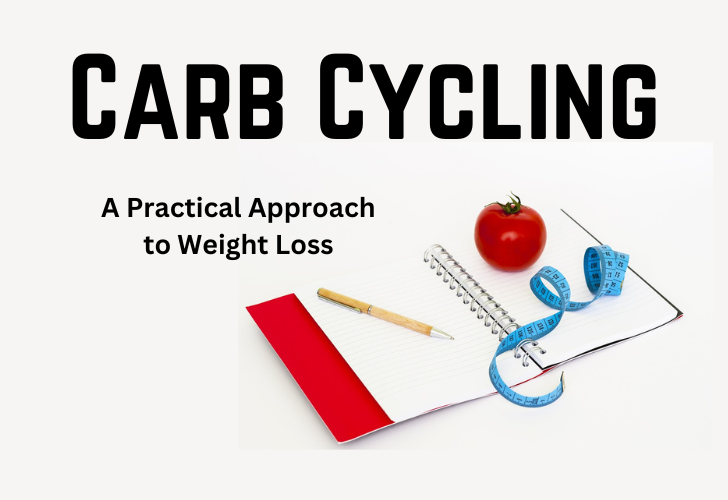
Carb Cycling for Weight Loss: 10 Benefits
What Are Carbs?
Let’s review the basics of carbohydrates before getting into carb cycling. Carbs, which are present in meals like grains, fruits, and vegetables, are the body’s main source of energy.
What is Carb Cycling?
Carb cycling is a fun game for your body. Rather than consuming the same amount of carbohydrates every day, you may eat slightly less on some days and a lot on others. It’s similar to surprise your body with a variety of meals to prevent boredom.
You get to enjoy delightful foods like grains, fruits, and vegetables on days when you consume a lot of carbohydrates. These days make you feel extra energetic, especially during workouts. There are also days when you consume less carbohydrates. Your body gains the ability to use fat that has been stored as fuel during these days, which aids in weight loss without sacrificing muscle mass.
Carb cycling is more of a lifestyle hack than a diet strategy. It’s about experimenting with your carb intake, much like a chef preparing a mouthwatering dish. This clever approach to meal planning contributes to an engaging and long-lasting weight-loss program. Cycling on carbs is a great strategy to maintain your health and fitness and is not just a passing fad.
What is Carb Cycling For Weight Loss
Carb cycling involves alternating between high and low carbohydrate intake throughout the week. This strategic approach aims to optimize fat burning while preserving muscle mass.
Wondering if carb cycling is a good way to lose weight? Well, it’s like giving your body a surprise party! Some days you eat more carbs, like pasta and fruits, making you feel all energetic. Other days, you eat fewer carbs, and your body learns to use stored fat, helping you lose weight.
Carb cycling isn’t a tricky diet; it’s more like a smart plan. It keeps your body guessing and prevents it from getting bored with the same foods every day. Plus, you don’t have to say goodbye to your favorite treats entirely.
The Benefits of Carb Cycling
1. Effective Fat Loss
- Carb cycling alternates days with high and low carbohydrate content to maximize fat burning. The body uses fat that has been stored as fuel on low-carb days, which encourages weight loss.
2. Preservation of Lean Muscle Mass
- In contrast to certain conventional diets, carb cycling ensures that the majority of weight loss comes from fat rather than muscle.
4. Sustainable Long-Term Approach
- A flexible and long-term weight loss strategy that offers variety in meal choices and avoids the boredom that typically accompanies strict diets is carb cycling.
5. Balanced Energy Levels
- Low-carb days help the body to burn stored fat, ensuring a balanced energy supply throughout the week, while high-carb days give an energy boost that supports vigorous activities.
7. Improved Insulin Sensitivity
Insulin sensitivity can be improved by carb cycling, which also lowers the likelihood of insulin resistance—a condition linked to weight gain—and helps control blood sugar levels.
8. Flexibility in Food Choices
- Eating a variety of foods is made possible by carb cycling, which facilitates sticking to the regimen. This adaptability may make dining more pleasurable and environmentally friendly.
9. Adaptability to Individual Needs
- Carb cycling is a personalized method to weight control since it can be tailored to meet individual needs, taking into account variables such as exercise level, metabolism, and personal preferences.
10. Positive Impact on Hormones
- Carb cycling can influence hormones like leptin and ghrelin, which play roles in hunger and satiety. This may result in better appetite control and improved adherence to the dietary plan.
How to Implement Carb Cycling
1. Determine Your Caloric Needs
- Determine your daily calorie needs depending on your weight, degree of exercise, and fitness objectives before beginning a carb cycling program.
2. Set Carb Intake Levels
- Set aside high-carb and low-carb days for the week. Eat more carbohydrates on high-carb days to fuel vigorous exercise, and concentrate on burning fat on low-carb days.
3. Choose Healthy Carbs
- For a consistent release of energy, choose complex carbs found in whole grains, fruits, and vegetables.
Overcoming Challenges in Carb Cycling
1. Perplexity in Meal Planning
- It can be difficult to prepare diverse meals that adhere to carb cycling criteria. Try different dishes to maintain your palette happy. Click Here to check the best meal planning app
2. Burstiness in Results
- Expect fluctuations in weight due to water retention and glycogen levels. Focus on the overall trend rather than daily fluctuations.
Conclusion
Carb cycling is a dynamic and flexible approach to weight loss that considers the body’s need for both carbs and fat. By incorporating this strategy into your routine, you can achieve sustainable and long-lasting results.






